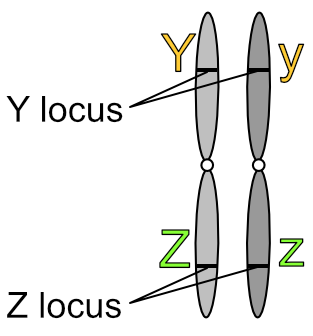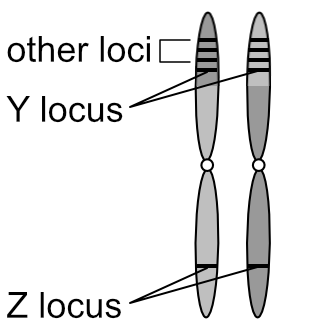Non-Mendelian Inheritance
This post will discuss non-Mendelian inheritance, but first let’s recap Mendelian inheritance.
Mendelian inheritance relies on three laws:
- the law of segregation
- the law of independent assortment
- the law of dominance
It’s important to stress that Mendel was referring to the segregation and independent assortment of what he termed ‘factors’, what we now call genes. His results suggested that these ‘factors’ of heredity behaved as units, or particles, that segregated and assorted independently of, and which were completely uninfluenced by, each other. One unit was as likely to end up in an organism with any other, unrelated, unit as not.
It wasn’t until 1902 that the concept of chromosomes and their being the carriers of multiple ‘factors’ (genes) was even suspected. In other words, genes did not exist as isolated particles, but instead resided on chromosomes with other genes.
Up until now this discussion has glossed over chromosomes as being the carriers of multiple genes, and focussed instead on tracking four alleles each on its own chromosome during meiosis. Showing these chromosomes independently segregating and assorting inferred the same behaviour on the alleles they carried — if chromosomes assorted independently, it made sense that the alleles did too.
Chromosomes do independently segregate and assort. But because they carry multiple genes, Mendelian inheritance doesn’t always apply at the gene level, so let’s explore the concept of non-Mendelian inheritance further with examples.
In the diagram below you’d expect the ‘Y’, ‘y’, ‘Z’ and ‘z’ alleles to stick with their respective homologues, ie you’d expect ‘Y’ and ‘Z’ to be inherited together and likewise for ‘y’ and ‘z’:
Here we say that the Y and Z loci are linked as they are on the same chromosome. Mendel’s first law of segregation still applies, as the ’Y’ and ‘y’ alleles, and the ‘Z’ and ‘z’ alleles, will still separate when their homologues separate during meiosis. But how do the genes at the Y locus independently assort from the genes at the Z locus if they are inherited together? This linkage of genes is the exception to Mendel’s second law.
Even so, this is an exception and not a complete breakdown of the law, for chromosomes have a tendency to cross over! This is when homologues exchange equivalent pieces of themselves during prophase 1 of meiosis before the chromosomes separate into separate gametes. Here, segments around the Y loci have been exchanged:
As the break occurred between the Y and Z loci, those alleles are now linked in a different combination — ’y’ is now with ‘Z’ and ‘Y’ is now with ‘z’ — and we say they have recombined. The genes at the Y and Z loci have still independently assorted as if they were on separate chromosomes the whole time. But there is a caveat.
Multiple crossovers are actually common during prophase 1, and loci that are far apart are the most likely to recombine often. There is less chance of breakages occurring between loci that are closer together, and thus more chance that closely linked loci are inherited together. This is represented below with the multiple loci bunched together at the tip of each chromosome having the same background colour as the respective Y locus:
Thus closely linked loci are more likely to be the exception to Mendel’s law of independent assortment.
Mendel’s third law of dominance is also subject to exceptions. This law assumes complete dominance, where one inherited allele is expressed and to the exclusion of its recessive counterpart. But as genetics progressed through the 20th century, it became more and more clear that other types of dominance existed.
Partial dominance, also called incomplete dominance, is where the expression of the heterozygote is somewhere between that of the two homozygotes. A classic example in animal breeding is the Andalusian fowl. Black feather colour is partially, not completely, dominant over white feather colour. A homozygous black chicken is fully black in colour and a homozygous white chicken is fully white in colour. Crossing the two produces offspring with slate-blue feathers. The white gene is a dilution gene which partially dilutes (washes out) the black colour. An all black chicken thus has no dilution of feather colour while a white chicken has fully diluted feather colour.
Codominance is where the expression of the heterozygote is exactly midway between that of the two homozygotes. Both genes are expressed equally. A classic example occurs in cattle: crossing a homozygous red bull over a homozygous white cow produces a roan calf, one with a coat of evenly mixed red and white hairs.
Overdominance is where the expression of the heterozygote outperforms that of the homozygous dominant genotype. An example is warfarin resistance in rats. The gene for resistance is dominant, and both heterozygotes and homozygotes for this gene are unaffected by warfarin. Warfarin thins the blood and prevents blood from clotting and in high enough concentrations will cause fatal internal bleeding. Vitamin K is a blood-clotting agent essential in the diet and counters warfarin’s action. Rats homzygous for warfarin resistance need a higher level of vitamin K than they can get naturally. Thus rats homozygously not resistant to warfarin as well as rats homozygous for resistance will both succumb to warfarin. Those that are heterozygous for resistance are unaffected. The warfarin-resistant gene is overdominant with respect to rat survivability: rats heterozygous for warfarin resistance outperform (survive) rats homoozygous for warfarin resistance.
Sex-linked inheritance is another example of non-Mendelian inheritance. The sex chromosomes in mammals are named X and Y. Females are XX and males are XY. Of genes found exclusively on the X chromosome (called X-linked genes), XY males will only have one copy while XX females will have two. A classic example of sex-linkage involves tortoiseshell cats. Tortoiseshell is a mixture of black and orange patches. All tortoiseshells are female*, because the gene for orange colouration is found only on the X chromosome. Possible genotypes in females are OO (orange), Oo (tortoiseshell) and oo (black). Males can only be O (orange) or o (black).
* In very rare cases a male may be XXY (this would be called Klinefelter syndrome in humans) and thus tortoiseshell, but also sterile.
And then there is epistasis, still another cause of non-Mendelian inheritance! Epistasis is where genes at one or more loci determine how genes at another locus — and this could be on a different chromosome — are expressed. An example is Labrador Retriever coat colour. ‘Labs’ come in three colours: black, yellow, and chocolate. These colours are determined by genes at the B (black) locus and E (extension of pigmentation) locus.
A phenotypically black Lab could be genotypically BBEE, BBEe, BbEE or BbEe. A yellow Lab could be BBee, Bbee or bbee. From this you can see that the expression of the ‘B’ allele is dependent on the presence of at least one ‘E’ allele. A dog homozygous for ‘e’ will always be yellow regardless of whether it also carries the ‘B’ allele. But dogs with at least one ‘E’ allele but homozygous for ‘b’ will be chocolate — possible genotypes in this case are bbEe and bbEE.
These are just some examples of non-Mendelian inheritance. But from the ones outlined above you’d be getting a good feel for just how complicated patterns of inheritance can be, and how fortuitous Mendel was to have chosen the pea traits he did to have been able to unravel the mysteries of inheritance at all! You may also be getting a feel for just how random genetic inheritance can be, and next week we’ll explore that randomness some more with a bit of maths.



Leave a comment